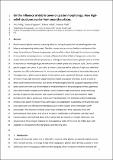Files in this item
On the influence of debris cover on glacier morphology : how high-relief structures evolve from smooth surfaces
Item metadata
| dc.contributor.author | Mölg, Nico | |
| dc.contributor.author | Ferguson, James | |
| dc.contributor.author | Bolch, Tobias | |
| dc.contributor.author | Vieli, Andreas | |
| dc.date.accessioned | 2021-02-15T00:41:29Z | |
| dc.date.available | 2021-02-15T00:41:29Z | |
| dc.date.issued | 2020-02-15 | |
| dc.identifier | 266448002 | |
| dc.identifier | 34801ae5-22d7-4907-bf76-461dbde3b3a1 | |
| dc.identifier | 85080040137 | |
| dc.identifier | 000527306200005 | |
| dc.identifier.citation | Mölg , N , Ferguson , J , Bolch , T & Vieli , A 2020 , ' On the influence of debris cover on glacier morphology : how high-relief structures evolve from smooth surfaces ' , Geomorphology , vol. In press . https://doi.org/10.1016/j.geomorph.2020.107092 | en |
| dc.identifier.issn | 0169-555X | |
| dc.identifier.other | RIS: urn:4B86373AA82FB6069E299D46383A1404 | |
| dc.identifier.other | ORCID: /0000-0002-8201-5059/work/69463497 | |
| dc.identifier.uri | https://hdl.handle.net/10023/21431 | |
| dc.description | This study was funded by the SNSF project #200021_169775 “Understanding and quantifying the transient dynamics and evolution of debris-covered glaciers”. | en |
| dc.description.abstract | Debris-covered glaciers receive increasing attention during this period of sustained negative mass balance and expanding debris cover. The debris cover induces various feedback mechanisms that shape the evolution of the glacier geometry, and also of its surface. Although the surface morphology of many debris-covered glaciers is markedly different from that of debris-free glaciers, only a few studies have combined different processes to investigate these characteristic glacier surfaces in order to improve our knowledge of glacier evolution on a wider spatial and temporal scale. Debris-covered glacier tongues can consist of parts with a smooth surface as well as surfaces of high local relief with abundant ice cliffs in the lower end. In this study we analysed the evolution of the surface features of Zmuttgletscher, a debris-covered glacier in Switzerland, over a period of 140 years using time series of historic maps, high resolution digital elevation models and glacier velocities, as well as data on debris cover extent and thickness. Our results revealed insights into the up-glacier expansion of the debris cover over time and the formation of medial moraines in the prolongation of the uppermost areas where debris emerged on the glacier surface. Moraine ridge prominence increased during periods of negative mass balance, and troughs developed in debris-free areas between ridges, persisting even after a continuous debris cover had developed. The changing surface morphology inhibits across-glacier meltwater flow, both supra- and subglacially. Accordingly, we found that large cryo-valleys with ice cliffs have formed down-glacier of the troughs where meltwater runoff accumulates. The meanders of these valleys have enlarged over time, especially by ice cliff backwasting at steep slopes, and most of the glacier width today is affected by such high-relief erosion features. We find that about 75% of all ice cliffs are located in this high-relief zone. The volume lost at these erosion features has increased by a factor of five since the 1980s, but is still negligible in comparison to the high glacier-wide thinning rates. | |
| dc.format.extent | 1735723 | |
| dc.language.iso | eng | |
| dc.relation.ispartof | Geomorphology | en |
| dc.subject | Debris-covered glacier | en |
| dc.subject | Surface morphology | en |
| dc.subject | Ice cliffs | en |
| dc.subject | Medial moraine | en |
| dc.subject | G Geography (General) | en |
| dc.subject | DAS | en |
| dc.subject.lcc | G1 | en |
| dc.title | On the influence of debris cover on glacier morphology : how high-relief structures evolve from smooth surfaces | en |
| dc.type | Journal article | en |
| dc.contributor.institution | University of St Andrews. School of Geography & Sustainable Development | en |
| dc.contributor.institution | University of St Andrews. Bell-Edwards Geographic Data Institute | en |
| dc.identifier.doi | https://doi.org/10.1016/j.geomorph.2020.107092 | |
| dc.description.status | Peer reviewed | en |
| dc.date.embargoedUntil | 2021-02-15 |
This item appears in the following Collection(s)
Items in the St Andrews Research Repository are protected by copyright, with all rights reserved, unless otherwise indicated.

